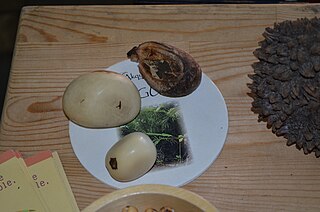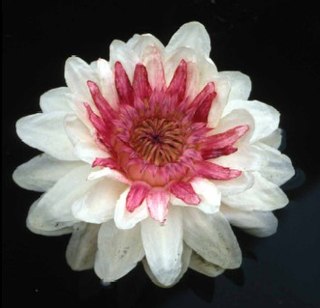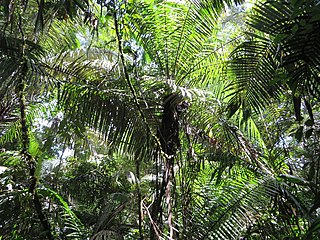Sagu or SAGU may refer to:
Sam, SAM or variants may refer to:

Vegetable ivory or tagua nut is a product made from the very hard white endosperm of the seeds of certain palm trees. Vegetable ivory is named for its resemblance to animal ivory. Species in the genus Phytelephas, native to South America, are the most important sources of vegetable ivory. The seeds of the Caroline ivory-nut palm from the Caroline Islands, natangura palm from Solomon Islands and Vanuatu, and the real fan palm, from Sub-Saharan Africa, are also used to produce vegetable ivory. A tagua palm can take up to 15 years to mature. But once it gets to this stage it can go on producing vegetable ivory for up to 100 years. In any given year a tagua palm can produce up to 20 pounds of vegetable ivory.

The palm tree Phytelephas aequatorialis, commonly known as Ecuadorian ivory palm, is the main source of Ecuadorean vegetable ivory or tagua, a botanical alternative to ivory. It is found in the tropical rainforests of the western Andean slopes of Ecuador. It has a woody trunk which can grow to 20 m in height and very long pinnate leaves.

Tingo María National Park is located in the districts of Rupa Rupa and Mariano Dámaso, in the region of Huánuco, Peru. It was established on May 14, 1965 and its main attractions are the montane forest vegetation and the cave named Cueva de las Lechuzas where the oilbirds nest. The park has an area of 4,777 hectares (18.44 sq mi) that include a mountain massif called La Bella Durmiente.

Phytelephas seemannii, commonly called Panama ivory palm, is a species of flowering plant in the family Arecaceae. It is one of the plants used for vegetable ivory.
Phytelephas tumacana is a species of palm tree. It is endemic to Colombia, where it grows in forests near rivers. It is threatened by the destruction of habitat for agriculture.

The Flora of Colombia is characterized by over 28,000 species of green plants.

Aphandra is a monotypic genus of flowering plants in the palm family native to the Amazon rainforest vegetation in South America. Its only species is Aphandra natalia, sometimes called mastodon palm or fiber palm, and is used by indigenous peoples in the construction of brooms and other products. This plant is commercially exploited for its edible fruits, and for its leaf sheath and petiole fibers. This fiber is almost equal to the fiber extracted from Attalea funifera and Leopoldinia piassaba, which is called piassava.

Pacaya–Samiria National Reserve, is a protected area located in the region of Loreto, Peru and spans an area of 20,800 km2 (8,000 sq mi). It protects an area of low hills and seasonally flooded forest in the Amazon rainforest. Pacaya-Samiria National Reserve and the near Tamshiyacu-Tahuayo Reserve both forms a biodiversity hotspot in the Amazon jungle.
Penicillium astrolabium is a fungus species of the genus of Penicillium.
Penicillium neocrassum is a terverticillate species of fungus in the genus Penicillium which was isolated from grapes.
Penicillium olsonii is an anamorph, filamentous species in the genus Penicillium which produces several polygalacturonases, xanthoepocin, asperphenamate, verrucolone, phthalate and olnacin. Penicillium olsonii is an often source of spoilage of tomatoes, salami and beans This species occurs ubiquitously in soil
Phytelephas schottii, the corozo palm, is a palm tree native to Colombia which bears a fruit which in Colombia is called corozo. The corozo fruit is often made into a sweet beverage called jugo de corozo.

Phytelephas macrocarpa is a single-stemmed, unarmed, reclining or erect palm from the extreme northern coastal regions of South America, growing to some 12 m tall. It has been introduced and cultivated in tropical regions all over the world. The trunk is about 30 cm across, with prominent leaf scars. The crown is made up of about 30 plume-like leaves or fronds, each about 8 m long, dead leaves being persistent. It is one of some 7 species of palm in the genus Phytelephas, all of which have been exploited for vegetable ivory or tagua from the seed or corozo nut. The closely related Ammandra decasperma from Colombia, and Aphandra natalia from Ecuador, are also sources of vegetable ivory, but of inferior quality and therefore not commercially significant. 'Phytelephas macrocarpa' translates to ‘elephant plant’ with 'large fruit', the endosperm of the nut having the texture of elephant ivory, and consisting of large, thick-walled cells of two long-chain polysaccharides, mannan A and B.
P. seemannii may refer to a few different species of plant. The specific epithet seemannii refers to someone with the surname 'Seemann,' in many cases it's botanist Berthold Carl Seemann (1825–1871).

Phytelepheae is a tribe of plants in the subfamily Ceroxyloideae of the family Arecaceae.

Phytelephas tenuicaulis is a species of palm in the genus Phytelephas. The compound leaves are around 7 meters in length, with stem diameters of 10 cm. Brown, ovulate fruits of about 6 cm are produced. Palms of the Phytelephas genus are also referred to as vegetable ivory palms.









